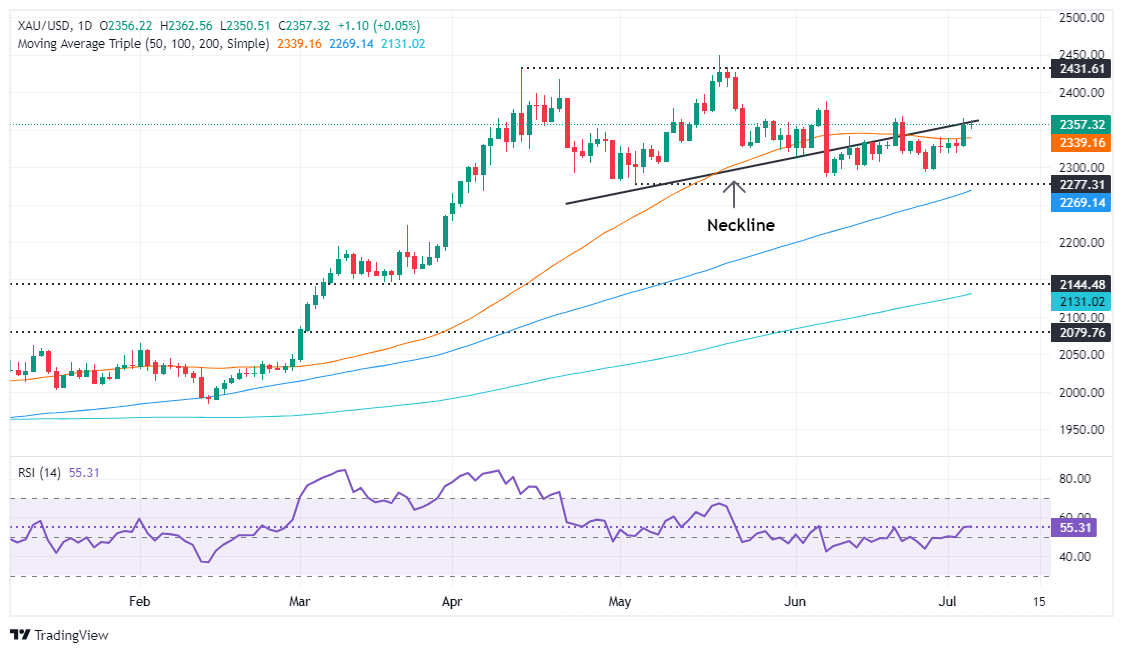- Gold prices edge up 0.15% amid thin trading on US Independence Day.
- XAU/USD reached a two-week high of $2,365 Wednesday, driven by weak US jobs data and heightened Fed rate cut expectations.
- Traders shift focus to Friday’s Nonfarm Payrolls report, following the US holiday closure.
Gold prices registers minimal gains on Thursday amid thin liquidity conditions during the North American session, as US traders are off their desks in observance of Independence Day. Recent economic data from the US augmented expectations that the Fed might begin to ease policy sooner than expected, yet policymakers remain vigilant and would like to see the disinflation process evolve further.
The XAU/USD trades at $2,356, up 0.15%, after hitting a two-week high at $2,365 on Wednesday.
Bullion rallied more than 1% on Wednesday on softer-than-expected jobs reports, led by last week’s Initial Jobless Claims and ADP data showing that private hiring deteriorated in June compared with May. Additionally, business activity in the services sector, tanked to contractionary territory as measured by the ISM Services PMI.
Meanwhile, the Federal Open Market Committee (FOMC) revealed June’s meeting minutes, which showed that most participants estimated that the current policy is restrictive but had opened the door for rate increases. Policymakers acknowledged the economy is cooling and could react to unexpected economic weakness.
Traders’ focus shifts to Friday’s Nonfarm Payrolls (NFP) report, as US markets remain closed due to the Independence Day holiday.
Daily digest market movers: Gold price stays firm above $2,350
- Earlier in the week, Fed Chair Powell remarked that the disinflation process has resumed but emphasized the need for further progress before considering any interest rate cuts. He added, “Because the US economy is strong and the labor market is strong, we can take our time and get this right.”
- On Friday, the US Nonfarm Payrolls report for June is expected to show that the economy added 190K jobs to the workforce, below May’s 272 K.
- The Unemployment Rate is expected to remain at 4% unchanged compared to previous readings, while Average Hourly Earnings (AHE) are projected to decelerate from 4.1% to 3.9% YoY.
- According to the CME FedWatch Tool, odds for a 25-basis-point Fed rate cut in September are at 66%, up from 63% on Tuesday.
- December 2024 fed funds rate futures contract implies that the Fed will ease policy by just 38 basis points (bps) toward the end of the year.
Technical analysis: Gold price fluctuates near Head-and-Shoulders neckline
Gold prices consolidate on Thursday due to thin volumes in the financial markets. Although the yellow metal remains bullish, the Head-and-Shoulders chart pattern is In the play, which began its formation in April 2024.
From a price action perspective, XAU/USD shows a near-term downward bias, but the overall bullish trend remains intact, supported by a bullish Relative Strength Index (RSI).
If the gold price breaks above the pattern’s neckline, it could rise to $2,400, invalidating the Head-and-Shoulders chart formation and potentially leading to further gains toward the year-to-date high of $2,450.
On the other hand, if sellers drive the spot price below $2,350, further declines could target the $2,300 level. If this support fails, the next demand zone would be the May 3 low of $2,277, followed by the March 21 high of $2,222.
Gold FAQs
Gold has played a key role in human’s history as it has been widely used as a store of value and medium of exchange. Currently, apart from its shine and usage for jewelry, the precious metal is widely seen as a safe-haven asset, meaning that it is considered a good investment during turbulent times. Gold is also widely seen as a hedge against inflation and against depreciating currencies as it doesn’t rely on any specific issuer or government.
Central banks are the biggest Gold holders. In their aim to support their currencies in turbulent times, central banks tend to diversify their reserves and buy Gold to improve the perceived strength of the economy and the currency. High Gold reserves can be a source of trust for a country’s solvency. Central banks added 1,136 tonnes of Gold worth around $70 billion to their reserves in 2022, according to data from the World Gold Council. This is the highest yearly purchase since records began. Central banks from emerging economies such as China, India and Turkey are quickly increasing their Gold reserves.
Gold has an inverse correlation with the US Dollar and US Treasuries, which are both major reserve and safe-haven assets. When the Dollar depreciates, Gold tends to rise, enabling investors and central banks to diversify their assets in turbulent times. Gold is also inversely correlated with risk assets. A rally in the stock market tends to weaken Gold price, while sell-offs in riskier markets tend to favor the precious metal.
The price can move due to a wide range of factors. Geopolitical instability or fears of a deep recession can quickly make Gold price escalate due to its safe-haven status. As a yield-less asset, Gold tends to rise with lower interest rates, while higher cost of money usually weighs down on the yellow metal. Still, most moves depend on how the US Dollar (USD) behaves as the asset is priced in dollars (XAU/USD). A strong Dollar tends to keep the price of Gold controlled, whereas a weaker Dollar is likely to push Gold prices up.

